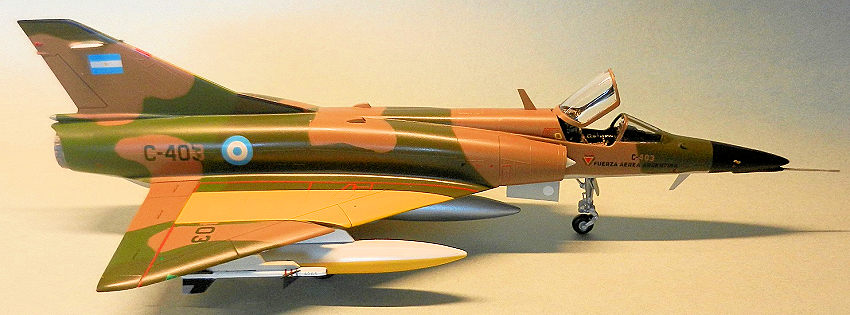
| KIT #: | 2634/4703 |
| PRICE: | CDN$30.00 |
| DECALS: | Three Options |
| REVIEWER: | Pablo Calcaterra |
| NOTES: | Condor & Aerocalcal decals, nose conversion. |

| HISTORY |
Early on May 1st, BAM (Military Air Base) Puerto Argentino/Port Stanley Airport was hit by bombs dropped by a RAF Vulcan and several low flying Harriers. The runway was hit by a bomb but continued operational for the rest of the war while infrastructure and parked planes received varying degrees of damage.
The FAA answered with several air patrols to try to intercept the SHARs and gain full air superiority. At 9:40, the Commander of the Task Force asked for the surrender of the Argentine garrison. When this request was emphatically rejected the detection of movement of helicopters and small ships around Puerto Argentino/Stanley made believe the defenders that a landing operation was being carried out. Thus the FAA sent strike combos to counteract the RN activities (these missions included three A-4C CAPs, armed with Shafrir missiles (https://modelingmadness.com/review/mod/us/cala4c.htm), to target the helos)
At 14:25 three RN warships started shelling the island. These were HMS Arrow, HMS Alacrity and HMS Glamorgan. As a consequence several missions were sent to attack them covered by Mirage IIIEA/Dagger CAPS. Among all the planes that took part in this air strike, we will center our attention around two Mirage 5 Dagger sections who were the only ones that succeeded in their mission: TORNO and FORTIN
TORNO:
Three Daggers armed with 2 x 250 kg bombs in stations 2 and 5 (located under the posterior part of the fuselage) and 3 x 1,300 lts fuel tanks (stations 2, 4 and 6), which gave them scarcely 2 minutes flying time over the area of operations at high speed and ultra low height. Flown byCaptain Dimeglio in C-432, Lieutenant Aguirre Faget in C-412 and 1st Lieutenant Román in C-407.
FORTIN
Two Daggers with 2 Shafrir missiles (stations 1 and 7) and 3 x 1,300 lt external tanks in the same position as TORNO. Flown by Captain Donadille in C-403 and 1st Lieutenant Senn C-421
All these planes were stationed in San Julián, and were part of the 2nd Moveable Squadron nicknamed “La Marinette”
TORNO, after taking to the air at 14:45, would descend to sea level 200 kilometers away from the islands to avoid radar detection. But when approaching the Sebaldes/Jason Islands, the air controller at Puerto Argentino warned them about the presence of a Harrier CAP that was heading in their direction. Therefore, using their airbrakes they dropped like stones to sea level until they were lost from the British screens. According to the orders they had received in Orden Fragmentaria 1105, the vessels were shelling Puerto Argentino/Stanley from Bahía de la Anunciación. Skimming the waters, they flew past the northern mouth of Estrecho de San Carlos/Falkland Sound and suddenly TORNO 2 saw a Harrier climbing into the clouds. Dimeglio decided to continue with their mission once alerted by his wingman. This SHAR had just fought against the Mirage IIIEAs of DARDO section (See https://modelingmadness.com/review/mod/fr/calm3e.htm). When they reached Cabo Corrientes/ Cape Carysfort the Daggers turned South, searching for their targets. The sea was calm and the ceiling was 500/1,000 feet.
Another pilot that gave his life and distracted another British CAP was 1st Lieutenant Ardiles who was shot down flying alone against the SHARs.
At a very high cost these air combats allowed the TORNOS to approach their targets unchallenged.
To their disappointment the enemy ships were nowhere to be seen within Bahía de la Anunciación. A quick glance to his fuel gauges told Capt. Dimeglio that they could still fly on some minutes to the South before returning to their bases in the mainland. The planes were flying in line abreast and 150 feet away from each other.
Meanwhile, FORTIN were in their station turning on a racetrack course 36,000 feet over Estrecho San Carlos/Falkland Sound with each Dagger covering the other on opposite sides of their flight pattern. During their ingress and while performing the standard armament check Capt. Donadille discovered his guns were not working. With the buzzing of his Shafrir in his headphones assuring him that he was not completely defenseless he decided to continue his mission. To lure the Harriers Donadille turned on his IFF.
On the radio they were able to listen to the communications between Capt.
García Cuerva and his wingman during the air combat with Penfold and Barton.
Then they listened García Cuerva’s report of the loss of Perona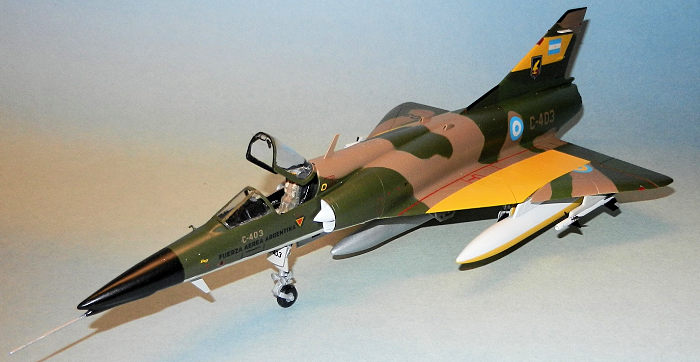 ,
his request to BAM Malvinas to land with his intact plane as he was low on
fuel...how the anxious argentine gunners started firing against the
approaching Mirage when he ejected his external loads….Shocked by the last
words said by García Cuerva, FORTIN flew on. Meanwhile, the flaming Mirage
IIIEA and his brave pilot were falling to the ground.
,
his request to BAM Malvinas to land with his intact plane as he was low on
fuel...how the anxious argentine gunners started firing against the
approaching Mirage when he ejected his external loads….Shocked by the last
words said by García Cuerva, FORTIN flew on. Meanwhile, the flaming Mirage
IIIEA and his brave pilot were falling to the ground.
At 16:35 hs and flying 50 feet above the water Aguire Faget saw in the direction of the airbase (to his right) the tracers being fired at the approaching Mirage IIIEA. A few moments later TORNO 3 (Roman) saw some explosions on the water and in the air ahead which reminded him of fireworks. He realized that those were the British guns firing against the Argentine positions. He informed his sighting to Dimeglio who after finding the enemy targets ordered his wingmen to attack the ship ahead of each one. The naval formation was milling in a circle calmly shelling the Argentines from a position aprox 12 miles SE of BAM Malvinas (Stanley Airport). Nine kilometers to the North, the Daggers were closing in on their targets...the approach would take them 40 seconds. When faced by the planes, the destroyer was at the left (target for Aguirre Faget), one Class 21 frigate at the center (target for Dimeglio), and the other one at the right (target for Román).
Flying at no more than 10 feet above the water, the Daggers accelerated and approached the ships. Dimeglio attacked the ship he had assigned to Aguirre Faget because it was closer, presented an easier target and reduced the time exposed to AA fire.
When they were close to the ships the pilots, except TORNO 3 who wanted to mask his approach as much as possible, started firing their guns. TORNO 1 and 2 attacked the destroyer from the stern. After dropping his bombs on Aguirre Faget’s ship, Dimeglio jumped over it, inverted his plane and put his wings perpendicular to the sea. Flying this way he passed between some antennas, then turned right and found that he was facing his originally assigned target. He shot the last rounds he had against it and flew as close as he could to the ship attacked by Román. Eventually, he was over land and after some miles, he climbed to the clouds.
Román also turned to the left after dropping his bombs and headed for the continent while climbing. Neither of them could see the result of their bombs as they were quickly left behind and they were fused to explode some seconds after impact. But flying behind and to the right of Aguirre Faget, Román saw the effect of his companion armament.
Aguirre Faget decided to lift his plane a little to aim better. He climbed to almost 3,000 ft. From the ground they saw how he was hotly attacked by the ships as he presented an easy target. A Sea Cat fired from the frigate on the center passed harmlessly below the Dagger though the British deny firing missiles to the attackers. Aguirre Faget didn’t see it, focused as he was on his target, and was later told about this “near miss”. Aguirre dropped his bombs while diving on the ship and then turned left over the open sea at nought feet. Román saw Aguirre Faget’s bombs exploding with fire and smoke, close to the destroyer. This fact was also seen by people on the ground. Because he had climbed to aim better he had given his bombs enough time to get properly armed.
The airplanes were not damaged by even a single piece of shrapnel or bullet. The ships aborted their shelling and rushed to open sea towards the rest of the Task Force.
As a result of the attack HMS Arrow was hit by several 30mm rounds, HMS Alacrity and the destroyer by close explosions of the bombs. According to the witnesses on the ground the larger ship slowly left the area, following the frigates that were sailing away at full speed. Still emitting smoke, the ship was lost in the horizon.
In the meantime and while climbing thru 20,000 ft and still above the islands TORNO flight was warned by the CIC at Puerto Argentino/Stanley that another British CAP was following them (the second one of the day). TORNO 3 didn’t hear the warning nor his leader telling his men to eject the ventral tank and dive under the clouds below. As a consequence Aguirre Faget kept on flying steadily with his 3 drop tanks on trying to maximize his fuel consumption while his 2 companions dove fast and hid under the clouds beneath…to find that they had been very lucky: the had ended up in a valley with hills higher on their sides! Still supersonic and now at very low height Dimeglio decided that they were using too much fuel and thus they both climbed again when they reached San Carlos Waters. Their flying altitudes now were: TORNO 1 at 42,000 ft, TORNO 2 at 21,000 ft and TORNO 3 at 30,000 ft.
The Argentine CIC kept a running commentary about the approaching SHARS on Aguirre Faget but he was still unable to receive and understand that he was in grave danger.
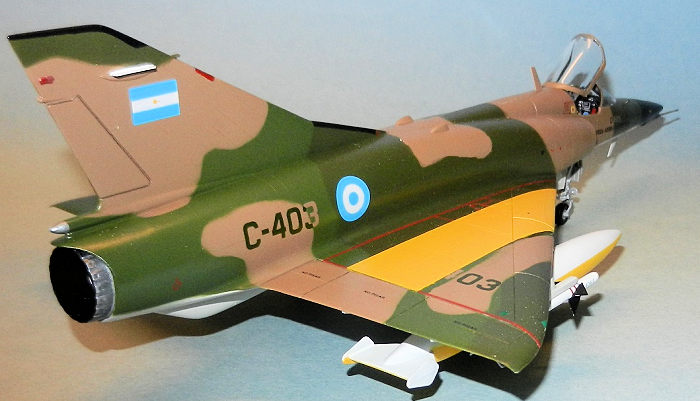 Eventually,
the CIC decided to send orbiting FORTIN in persecution of the pair of
Harriers that was threatening TORNO 2. They ejected their external tanks and
accelerated to 1.4 Mach.
Eventually,
the CIC decided to send orbiting FORTIN in persecution of the pair of
Harriers that was threatening TORNO 2. They ejected their external tanks and
accelerated to 1.4 Mach.
The CIC Radar gave them a vector to reduce the distance as fast as possible while feeding them with the distance between TORNO 2 and the British CAP and the one separating FORTIN from the SHARs. Flying supersonic the Daggers starting to catch up the Harriers faster than these were approaching TORNO 2. The problem they faced is that the interception course was 320 degrees and this was putting the sun straight ahead. The Shafrir were locked on the sun, the Daggers had no radar on board and Donadille and Senn were running the risk of overtaking the Harriers…thus becoming the hunted. Effectively the only armament the Daggers had were the 30 mm guns on Senn’s plane.
At the moment that the distance between the SHARS and FORTIN was 1.5 miles and it seemed that a dramatic end could happen the British pilots, clearly alerted by their own controller, made a Split S and left the persecution of TORNO 2.
It was the end of a 150 km long pursuit for FORTIN flight.
As they did not have modern navigational equipment, all that the Dagger pilots could do to get back home was point their noses in the direction of the continent (the setting sun) and estimate their distance to their base by the time they had been in the air. Dropping their remaining external tanks to reduce drag allowed them to reach BAM San Julian with just enough “juice” to land.
Upon landing the 5 pilots embraced each other. They had successfully carried out the first air to sea attack in the history of the Argentine Air Force. As Capt. Donadille stated later on...he had chased the Harriers away armed only with a bladeless knife (“el mango del cuchillo”) as his guns were not working and his missiles were locked on the sun. The happiness of their accomplishment was somehow dimmed with the loss of García Cuerva and Ardiles.
The attack had also proven wrong the Argentine Navy’s assessment that claimed that the RN warships were so powerful that less than half of any attacking force had a chance of coming back. Spirits in the Air Force pilots rose as a consequence of this attack. They now realized that they had a good chance of getting away unharmed after attacking the Task Force. Not everything seemed to be so gloomy now.
The next and last mission flown by C-403 (again with Capt. Donadille in the cockpit) goes as follows:
It was May 21th during the afternoon. Two waves of Argentine attack planes had already tried to dislodge the beachhead the Task Force was trying to establish in San Carlos.
Two further waves were planned. As part of the third one, 2 sections of 3 Mirage V Daggers from San Julian were to attack with 1-minute interval. They were the sections called Lauchas and Ratones and they were supposed to attack in this order.
The Ratones were: Captain Guillermo Donadille in C-403, Major Gustavo Piuma Justo in C-404 and 1st Lieutenant Jorge Senn in C-407. The recently trained in Daggers Piuma Justo had trouble starting the engine of his plane, so the Lauchas took the lead after Donadille gave the authorization.
Once the problem was solved, they flew straight to the target area, as they would be in the limit of their range. Around 80 NM from the islands, the 3 Daggers were flying skimming the waves. Though at that time the MVs did not have any navigation equipment, based on speed and compass they were able to get to the Sebaldes Is. Only 20 seconds late.
Just before arriving at Gran Malvina (West Falklands) they heard the Air Controller saying that there was great activity of Harriers in Estrecho de San Carlos (Falkands Sound) and to the North of it.
Now, flying over Gran Malvina, the planes opened their formation: the three planes were now in a single line, side by side, 600 mt. Apart: Donadille, navigating, in the center, Piuma to the left and Senn to his right, controlling the air around them.
Stationed on their patrol area under the control of HMS Brillant, Sharky Ward in Sea Harrier ZA175 (Commander of 801 Sqn flying from HMS Invincible) and his wingman, Steve Thomas in ZA190, were turning in parallel circles over Gran Malvina. Unknown to them, on the route the Daggers intended to take!
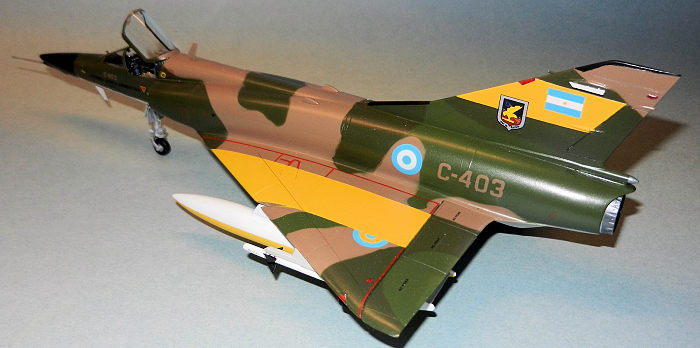
When both Harriers, flying in their parallel circuits, were turning North, Thomas looked below and behind him and saw 2 triangles flying East fast. Donadille and Senn. That is why Senn said that they had not been detected by the Harriers, as Thomas only saw the Argentines when he was above them and not when he was still to their right, about to cross their path. He alerted Ward and immediately gave chase, turning his height into speed to try to catch the Argentine planes.
At that instant, the dark plane that Donadille saw (Ward) turned to the left and it is then that Donadille is able to see the plane from “above”. He immediately realized it was a Sea Harrier. The Ratones leader commanded: “Drop ordinance and face him”. Senn said: “He has not seen us” but Senn was talking about Thomas’ Harrier that initially had crossed above them. Senn did not realize that the plane that Donadille was looking at (Ward) was curving to get on the tail of Senn himself (#3). So Donadille commanded sharply: “Drop the ordinance, damn! And break right!” So finally Senn did as he had been told and started to turn gently to his right. Besides, as we have seen, Thomas had in fact seen them.
Ward was turning in such a way that he was going to get on Senn’s tail before Donadille could prevent it, so in despair he fired his guns in the general direction of Ward, who later said that he was surprised that their enemies were staying to fight instead of continuing their path to attack the Task Force, or even returning to their bases. At this moment, Donadille was 90 to the side of Ward. Her firing guns illuminated the belly of the Dagger and at that moment Ward broke to his left, now flying head on against the 2 Daggers. Donadille was higher and Senn lower.
Finding that he had not been loaded with tracers that would have helped him to aim better, Donadille then dove towards the head on coming and also diving Ward, firing again this time ahead of the Harrier. If the Harrier was to cross the trajectory of the 30 mm guns, some rounds might hit her. Focused on his aim, Ward flew 400 mt away and below from Donadille, extremely low over the ground. So low that Donadille considered that the Harrier might have crashed. Now Donadille started to climb, fighting the inertia of the plane, which with the internal tanks still full of fuel, avoided the ground by 5 to 10 meters.
At this moment, unknown to Donadille, Thomas had managed to get on his tail. Piuma was still climbing and turning right and Senn was now turning to his right very steeply. So when Donadille started to climb, he found Senn in his path. To avoid crashing against his wingman that had condensation trails in his wingtips, Donadille was forced to turn left (and put his plane almost upside down) and crossed his wingman very close.
A few seconds later, turning again to his right, and trying to see what had happened to the Harrier he had fired at, Donadille received the impact of the first of Thomas’ missiles. The damaged Dagger went into “porpoise” (sudden up and down movements) and a few meters above the ground it went into a flat spin. The control of his plane lost, Donadille ejected and no more than 20 seconds later, he touched the ground. Approximately 500 meters ahead of him, his Dagger crashed and erupted in flames.
By now, Piuma had levelled his plane and was able to see the combat
taking place below him, on his right side thru the broken clouds. Two Sea
Harriers were getting on Senn’s tail who had now reversed his turn, going to
his left (West) and trying to face the threat on his tail: Ward doing a turn
that really surprised Piuma watching from above as it was really tight (one
of the great advantages of the Harrier) and another one, Thomas,
approximately 700 meters away and below, 90 degrees from the tail of the
Dagger. The missile left the left wing of Thomas’ Harrier and Piuma shouted
to Senn to
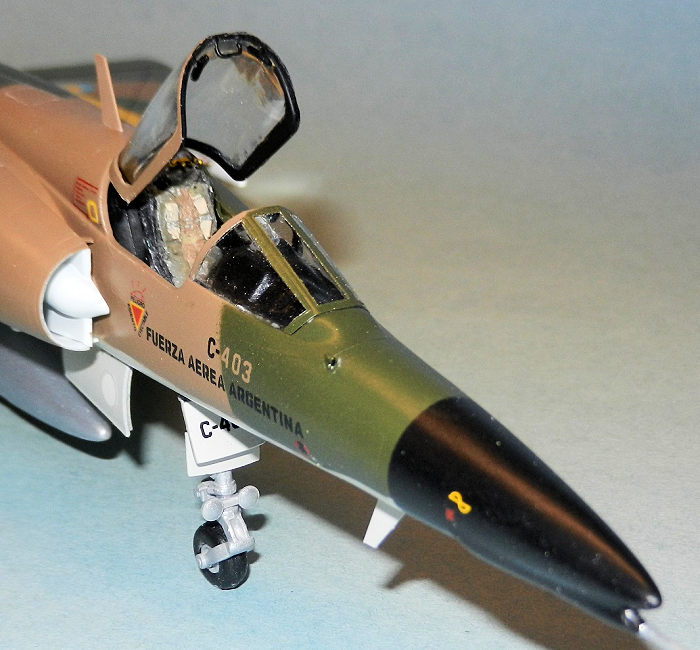 break his
turn, but the Sidewinder ate the distance in a very short time and C-407 was
hit above the left wing, close to the tail.
break his
turn, but the Sidewinder ate the distance in a very short time and C-407 was
hit above the left wing, close to the tail.
Piuma called Donadille on the radio, but of course received no answer. Then he saw the second Harrier (Ward) gently turning to the left (North) below him at around 40 meters over the ground. The last Argentine pilot dove on the unsuspecting Ward. Ward and Thomas had started to fly together in a CAP again, flying East. Piuma got inside Ward’s turn and 600 meters away, 30 degrees to the left and slightly above the Harrier he fired a long burst at Ward. Piuma stop firing when he realized he also did not have tracers. The Harrier went into a valley and Piuma thought that Ward was not going to get away from him. At that moment, he was doing 450 knots and was now 40 meters above the ground. He saw a pilot hanging from his parachute (Senn). After looking at the pilot hanging from the parachute, Piuma felt a great explosion on his plane. He ejected when he felt the heat of his plane on fire. Ward and Thomas had seen a Dagger flying lower than them running Northeast. Ward got under and behind the tail of the last Dagger and fired his missile. The plane cartwheeled after exploding. Piuma had overtaken the Harriers and got fired by his intended target.
The 3 Daggers were shot down and potential more damages to the British Task Force were prevented (on this day, out of the 7 warships that entered the Sound, 5 were hit: HMS Ardent sinking the following day, HMS Antrim and Argonaut were badly mauled and forced to leave the zone of operations for the rest of the war, HMS Brillant and Broadsword were damaged by 30 mm gun rounds). Only two days later did the Argentine planes started to hit the transport ships, but by then it was too late and the beachhead was firmly established.
After resuming their patrol, the two Harrier pilots lost sight of each other. Ward was afraid that Thomas had been shot down, as he was not answering his calls. Upon landing back in HMS Invincible, Ward found that Thomas had just landed, his plane damaged by 3 rounds in the electronics bay in the tail area. Apparently, he was hit by a machine gun of the Argentine Army while flying low over Fox Bay.
The Argentine pilots spent the night in the open, Piuma injured and only able to walk on his 4, Donadille with his eyesight affected by the ejection and Senn in good physical shape. It would take them between 1 and 2 days in the open before they were rescued by the Argentine forces and then be returned to the continent in one of the several H-130 flights of the Argentine Air Force that broke almost daily the blockade imposed by the Task Force. But their rescue is another (long and interesting) story…
This can be probably considered the last true dogfight in the 1982 war. I say so because from that moment onwards, every time the Argentine pilots were under attack from Sea Harriers, and knowing it was pointless to try to face the Sea Harrier/Sidewinder combination, they tried avoid the combat and return to their continental bases.
| THE KIT |
I built the plane using the latest edition of the Italeri/Esci kit:
raised and missing panels, not very well engineered as for instance the top
and bottom parts for the wings don’t follow the actual panels so
 these
unions need to be erased with Putty and thus losing some details…on the
positive side the exhaust cone has some sort of detail inside (which were
not present in the original 1983 issue). There are some sink marks in the
landing gear doors, top side of the border of attack of the wings but no
flash.
these
unions need to be erased with Putty and thus losing some details…on the
positive side the exhaust cone has some sort of detail inside (which were
not present in the original 1983 issue). There are some sink marks in the
landing gear doors, top side of the border of attack of the wings but no
flash.
It has 2 types of drop tanks (supersonic and 1,700 lt), some bombs, 3 types of missiles (including the Matra 550 used by the Argentine Air Force during the war in their MIIIs) and decals for several versions: Australian, Spanish, French, Swiss. Two exhaust types (C and E version) are supplied. So there are plenty of versions to be built with this kit.
| CONSTRUCTION |
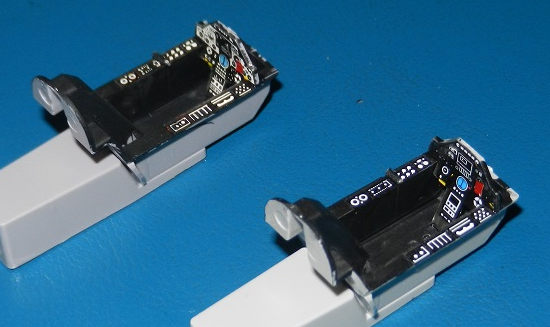 Typically
started with the cockpit where I left out the seat as had some resin copies
made that were to be added at the last moment. The decals on the main
instrument panel were slightly modified with red and yellow paint to
represent some of the extra lights (i.e. alarm panel). I also scratchbuilt
the throttle and glued it on the left side console. The fuselage halves were
then glued together.
Typically
started with the cockpit where I left out the seat as had some resin copies
made that were to be added at the last moment. The decals on the main
instrument panel were slightly modified with red and yellow paint to
represent some of the extra lights (i.e. alarm panel). I also scratchbuilt
the throttle and glued it on the left side console. The fuselage halves were
then glued together.
The bottom side of the wings was glued centered. To make a more sturdy union of the wings-fuselage, I cut some pieces of plastic sprue and placed them on the inside of the bottom wings below the top wing halves close to the fuselage. This prevented this area from being pushed doing during handling the kit.
Using a Nesher/Dagger resin nose as a template I made several molds using Plaster of Paris. Once the halves had dried out (I made 3 for each side of the nose) I took two part epoxy glue (the one that comes in with two “syringes” that are deliver their content by pressing on a single trigger) and deployed the thoroughly mixed paste inside the molds. As it is quite soft and runny it filled all the panels and contour very well. The following day I broke the Plaster of Paris and freed the 6 halves. Clearly there was some excess of epoxy here and there that had to be cut out. Sanding the mating surfaces carefully I then was able to deliver 3 new noses. It is a cheap system that requires a little bit of extra work. I picked one of the pairs and using more 2 part epoxy glue I joined them together. Once dried I wet sanded the overflowing glue, rounded the surfaces and set the nose aside.
 The IFF
system on the tail is placed on top of some oval supports. I cut these shapes
from plastic and used Putty to improve the union sanding the edges improving the
curvature. The new nose was added and the union was improved using some putty
and sandpaper. The three drop tanks were made using resin and a silicon mould I
made many years ago. These required lots of work to fix some imperfections in my
copies. The air intakes were given a coat of white paint and glued together
leaving them aside for the final stages of the project.
The IFF
system on the tail is placed on top of some oval supports. I cut these shapes
from plastic and used Putty to improve the union sanding the edges improving the
curvature. The new nose was added and the union was improved using some putty
and sandpaper. The three drop tanks were made using resin and a silicon mould I
made many years ago. These required lots of work to fix some imperfections in my
copies. The air intakes were given a coat of white paint and glued together
leaving them aside for the final stages of the project.
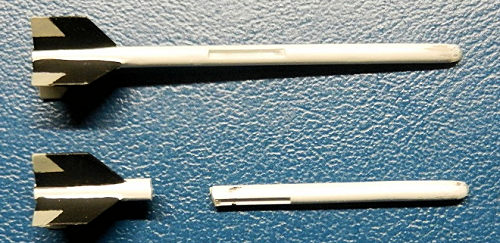 The Shafrirs
were made using the kit missiles. These are 1 cm too long so I removed part of
the main body and also cut out the forward wings. The tips of the missiles were
sanded flat and a piece of clear plastic placed instead. Then this clear piece
was rounded and streamlined with the main body using sandpaper. Landing gear and
wheels were assembled and set aside.
The Shafrirs
were made using the kit missiles. These are 1 cm too long so I removed part of
the main body and also cut out the forward wings. The tips of the missiles were
sanded flat and a piece of clear plastic placed instead. Then this clear piece
was rounded and streamlined with the main body using sandpaper. Landing gear and
wheels were assembled and set aside.
The VHF and IFF antennas were cut from strips of Evergreen. I made them slightly longer to bury them in blue tac to paint them. They were painted in tan (top VHF), light grey (bottom VHF) and white (IFF). Once dry the part that was buried in blue tac was cut out delivering the proper length for these parts.
| COLORS & MARKINGS |
I used ModelMaster Acrylic paints. First I used Light grey (4766) for all the undersurfaces, followed by Tan (4709), then Medium Green (4734) and finally Dark Green (4726). The demarcation lines between colours are not sharp so I used Blue Tac to obtain the desired effect. The yellow (4683) ID bands were painted on wings and tail…oddly enough C-403 had the yellow ID painted on the left side of the tail and not on the right side.
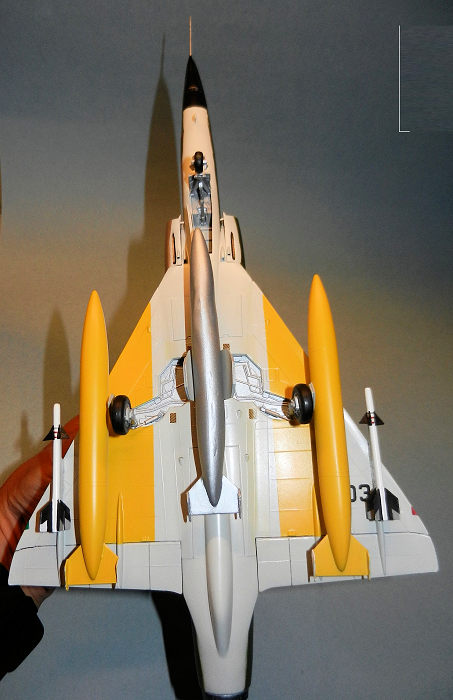 The 30 mm
guns openings were painted with black as the front of several air intakes around
the plane.I masked the undersurfaces and then proceeded to paint the landing
gear wheels and internal side of landing gear doors in aluminum. At the same
time I painted the landing gear legs and wheels discs.
The 30 mm
guns openings were painted with black as the front of several air intakes around
the plane.I masked the undersurfaces and then proceeded to paint the landing
gear wheels and internal side of landing gear doors in aluminum. At the same
time I painted the landing gear legs and wheels discs.
The nose was masked and painted black like the internal surface of the windshield and canopy frames (these last where then painted with the cammo colours). The ventral tank was painted in aluminium and the ones under the wings in white (top) and yellow (bottom). Missiles were painted white with black wings. The ones on the back of the missiles had grey rectangles. Moveable surfaces of the plane were highlighted using a 4B pencil.
The landing gear was added (minus wheels) and then Future gave a gloss surface for the decals: a mix of Italieri (some stencils), Condor Decals (Grupo 6 badge on the tail) and AeroCalcas for the tail numbers. Now these don’t include the green “3”s I needed so cutting tiny pieces from green decals sets I had used in the past I created those missing numbers. It was a painful task and these “3”s are made up of probably 10 or more chunks of green decals.
Another interesting detail for C-403 (besides the lack of yellow ID band on one side of the tail) is that at least the white portion of the Argentine roundel on top of the left wing was painted out in yellow. This is based on pictures of the crashed plane where this detail is very evident. So with a thin brush I carefully painted this area in yellow.
Serial numbers for the missiles were made using the blue (should have been red but I did not have any good ones available) numbers that indicate the decal number on the AeroCalcas sets with a grey strip to simulate the moveable arc for the front winglets and two red strips from the spares box behind it.
| FINAL CONSTRUCTION |
The air intakes and wheels were added then a coat of semi gloss clear varnish from AeroMaster sealed the decals. All the position lights were painted first with light grey, followed by aluminum and then ModelMaster clear green or red. Hydraulic actuators and landing lights were painted Silver. These last ones received drops of Future to represent the front covers.
The sequence to add all other parts started from the center moving outwards: ventral tank, main landing gear doors, wing drop tanks, missiles (with the forward winglets in a drooped position as seen in pictures taken during the war when the planes were on the ground).
Then I moved to the top portion of the plane. Gunsight, compass and clock (scratchbuilt) on the windshield, windshield, ejection seat (a large chunk of resin was sanded away to make it fit thus losing some details), stick, VHF and IFF antennas, the little antenna in front of the tail.
The model was finished when I scratchbuilt the prominent pitot tube on the nose and the last detail was the canopy with photoetched mirrors and the central handle.
| CONCLUSIONS |
A very satisfying build…And actually a double one! Because I built not one but two C-403s at the same time! One for me and using an older Esci Mirage IIIEA (Malvinas/Falklands kit from 1983) the other one was built for no other than the then Captain Guillermo A Donadille (the only difference between mine and his is that I used the AeroCalcas Grupo 6 decal in his with a hand painted silver edge) who has received from my hands his model during the week of December 2nd 2017.
| REFERENCES |
Dagger & Finger, Núñez Padín
Dios y los Halcones, Pablo Carballo
Halcones sobre Malvinas, Pablo Carballo
La Guerra Inaudita, Rubén Moro
La Batalla Aérea de nuestras Islas Malvinas, Pío Matassi
Aeroespacio issue #534
Ellos también combatieron, Guillermo Posadas
La Fuerza Aérea en Malvinas, Tomo I
The Falklands War, Duncan Anderson
Harrier over the Falklands, Nigel Ward
Guerra Aérea en las Malvinas, Benigno Andrada
Personal interviews with Donadille, Piuma, Senn and Aguirre Faget
Back to the Main Page Back to the Previews Index Page Back to the Previews Index Page